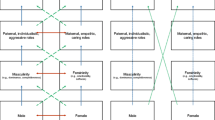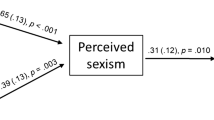Abstract
This study investigated the role and trait components of sex-biased occupational beliefs. A repeated-measures analysis of variance design was used to assess the agreement patterns of 198 female and male undergraduates to three types of sentences: (1) traits necessary for a variety of occupations (job requisites); (2) the relative possession of these traits by men and women (traits); and (3) the relative suitability of women or men for these occupations (roles). A significant sex of subject by sentence type interaction was found, indicating that the sex of the subjects as well as the type of sentence (job, role, or trait) contributed to overall occupational beliefs. Moreover, tests of the simple main effects revealed that sentence type was significant for both females and males, and that sex was significant within two of the three levels of sentence type: job requisites and role statements. The results indicated that greater understanding of occupational stereotyping may be attained through research aimed at distinguishing between role and trait components of job stereotypes.
Similar content being viewed by others
References
Anderson, N. Likableness ratings of 555 personality-trait words. Journal of Personality and Social Psychology, 1968, 9, 272–279.
Bowman, G., Worthy, N., & Greyson, S. Problems in review: Are women executives people? Harvard Business Review, 1965, 43, 52–67.
Broverman, I., Vogel, S., Broverman, D., Clarkson, F., & Rosenkrantz, P. Sex-role stereotypes: A current appraisal. Journal of Social Issues, 1972, 28, 59–78.
Cecil, E., Paul, R., & Olins, R. Perceived importance of selected variables used to evaluate male and female job applicants. Personnel Psychology, 1973, 26, 397–404.
Clifton, A., McGrath, D., & Wick, B. Stereotypes of woman: A single category? Sex Roles, 1976, 2, 135–147.
Cohen, S., & Bunker, K. Subtle effects of sex role stereotypes on recruiters' hiring decisions. Journal of Applied Psychology, 1975, 60, 566–572.
Hesselbart, S. Women doctors win and male nurses lose. Sociology of Work and Occupations, 1977, 4, 49–62.
Maccoby, E., & Jacklin, C. The psychology of sex differences. Stanford: Stanford University Press, 1974.
Miner, J. Studies in management education. New York: Springer, 1965.
Oppenheimer, V. The sex-labeling of jobs. Industrial Relations, 1968, 7, 307–325.
Reiss, D., Duncan, O., Hatt, P., & North, C. Occupations and social status. New York: Free Press, 1971.
Rosen, B., & Jerdee, T. The influence of sex-role stereotypes on evaluations of male and female supervisory behavior. Journal of Applied Psychology, 1973, 57, 44–48.
Rosen, B., & Jerdee, T. Influence of sex role stereotypes on personnel decisions. Journal of Applied Psychology, 1974, 59, 9–14.
Rosenkrantz, P., Vogel, S., Bee, H., Broverman, I., & Broverman, D. Sex-role stereotypes and self-concepts in college students. Journal of Consulting and Clinical Psychology, 1968, 32, 287–295.
Schein, V. The relationship between sex role stereotypes and requisite management characteristics. Journal of Applied Psychology, 1973, 57, 95–100.
Schein, V. Relationships between sex role stereotypes and requisite management characteristics among female managers. Journal of Applied Psychology, 1975, 60, 340–344.
Terborg, J. Women in management: A research review. Journal of Applied Psychology, 1977, 62, 647–664.
Terborg, J., & Ilgen, D. A theoretical approach to sex discrimination in traditionally masculine occupations. Organizational Behavior and Human Performance, 1975, 13, 352–376.
Touhey, J. Effects of additional women professionals on ratings of occupational prestige and desirability. Journal of Personality and Social Psychology, 1974, 29, 86–89.
United States Bureau of the Census. 1960 Census of population, alphabetical index of occupations and industries. Washington, D.C.: U.S. Government Printing Office, 1960.
Winer, B. J. Statistical principles in experimental design. New York: McGraw-Hill, 1971.
Author information
Authors and Affiliations
Additional information
This research was completed as part of the first author's doctoral dissertation research while supported by an NIMH Traineeship at Michigan State University. Use of the Michigan State University computer facilities was made possible in part through support from the National Science Foundation.
Rights and permissions
About this article
Cite this article
Mellon, P.M., Crano, W.D. & Schmitt, N. An analysis of the role and trait components of sex-biased occupational beliefs. Sex Roles 8, 533–541 (1982). https://doi.org/10.1007/BF00287717
Issue Date:
DOI: https://doi.org/10.1007/BF00287717




